

Accessibility_Online_Learning_17Oct06.pdf. Issues in Online Learning Accessibility. Online Education and Students with Disabilities. Students with disabilities represent a significant percentage of the overall student population and in fact, recent statistics indicate that there are approximately 400,000 students in post-secondary education with a disability.
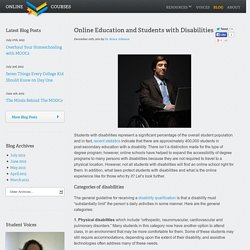
There isn’t a distinction made for the type of degree program; however, online schools have helped to expand the accessibility of degree programs to many persons with disabilities because they are not required to travel to a physical location. However, not all students with disabilities will find an online school right for them. In addition, what laws protect students with disabilities and what is the online experience like for those who try it? Let’s look further. Categories of disabilities The general guideline for receiving a disability qualification is that a disability must “substantially limit” the person’s daily activities in some manner. 1. 2. 3.
ITD Journal: Accessible IT: Lessons Learned From Three Universities. Sheryl Burgstahler University of Washington Alice Anderson University of Wisconsin - Madison John Slatin.
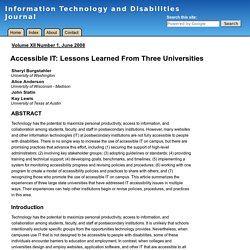
LD OnLine: The world's leading website on learning disabilities and ADHD. COLSD. Inclusive Information and Communication Technologies for People with Disabilities. Introduction.
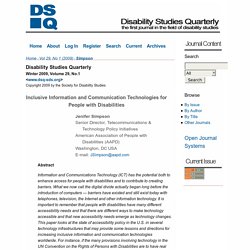
Untitled. 1.
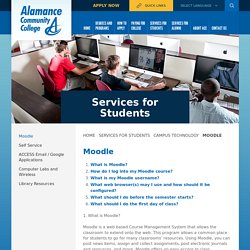
What is Moodle? Moodle is a web based Course Management System that allows the classroom to extend onto the web. This program allows a common place for students to go for many classrooms’ resources. Using Moodle, you can post news items, assign and collect assignments, post electronic journals and resources, and more. Moodle offers an easy access to class documents. Online College Learning for Students with Disabilities. A 2008 amendment to the American with Disabilities Act (ADA) mandates that qualified people with disabilities have access to public programs and services, including those offered on the Internet.

This means that if a student with a disability enrolls in an online learning course, the course should be made accessible to him or her. The ADA, however, has not provided any specific accommodation standards. Thus, it’s up to each school to determine how far to go to serve its population of students with disabilities. With disabilities encompassing such a broad spectrum, creating educational content that is easily accessible to all presents significant challenges. Yet many universities see it as their moral duty to exceed ADA requirements. Dave Cillay, vice president at Washington State University’s Global Campus also believes access is both a legal right and an ethical responsibility. Making Blended Instruction Better: Integrating the Principles of Universal Design for Instruction into Course Design and Delivery.
Making Blended Instruction Better: Integrating the Principles of Universal Design for Instruction into Course Design and Delivery Source:Action in Teacher Education, v. 31 no. 1 (Spring 2009) p. 38-48.
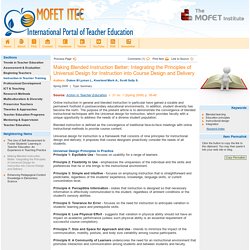
Online instruction in general and blended instruction in particular have gained a sizable and permanent foothold in postsecondary educational environments. In addition, student diversity has become the norm. The purpose of the present article is to demonstrate the convergence of blended instructional techniques with the Universal design for instruction, which provides faculty with a unique opportunity to address the needs of a diverse student population.
Online%2BVersus%2BFace-to-Face%2BAccommodations%2BAmong%2BCollege%2BStudentsWith%2BDisabilities.pdf. Report_dev1.1. 2012_just_025_european_accessibiliy_act_en.pdf. H810 - Accessible online learning: supporting disabled students - Open University Course. On this page This online module is concerned with improving access to learning for disabled students.
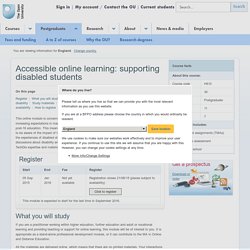
There are increasing expectations in many countries that disabled students should be able to participate fully in post-16 education. This means that people responsible for provision in academic and support roles need to be aware of the impact of this on how courses are designed and delivered online. The module looks at the experiences of disabled students, the technical aspects of accessibility, and current debates and discussions about disability and accessibility in educational contexts.
This module benefited from JISC TechDis expertise and materials in its production. Register What you will study. Online College Learning for Students with Disabilities. E-Learning Accessibility & Usability. By Aina Irbe, Training Manager After 18 years in the field of e-Learning and as a doctoral learner in instructional design and online learning, I am intrigued by the intersection of usability and accessibility in the many delivery options offered by the online learning environment.
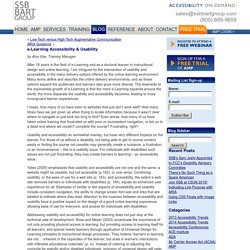
Many terms define and describe the online delivery environments, and as these options expand the audiences and learners also grow more diverse. The downside to the exponential growth of e-Learning is that the more e-Learning expands around the world, the more disparate the usability and accessibility becomes, leading to more incongruent learner experiences. I mean, how many of us have been to websites that just don’t work well? How many times have we just given up when trying to locate information because it wasn’t clear where to navigate or just took too long to find? Usability and accessibility do somewhat overlap, but have very different impacts on the learner. Rose, D., & Meyer, A. (2002). Learning technologies for people with disabilities.
Abstract.
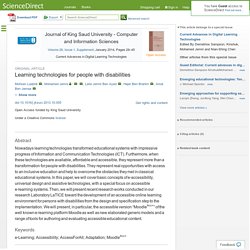
Understand These 10 Principles of Good Design Before You Start Your Next eLearning Project. Understand These 10 Principles of Good Design Before You Start Your Next eLearning Project Wether you are just getting started with eLearning design and looking to get a better understanding of eLearning best practices, or you've been designing courses for a while and are trying to find ways of making your material more effective, considering the basics of visual design is key.

Design is too often overlooked by course developers, or otherwise misunderstood – some eLearning designers think that as long as their course "looks good," the visuals are sufficient. But graphical composition and design affect the way a learner takes in information, so giving a bit more thought to the visual layout of the pages of your course is an important part of eLearning best practices. Try these ten simple changes, and see the difference they make. 1. The placement of the elements on each page should flow naturally from one to the next in a progression that lends itself to the content you're teaching. 2. 3.
What is Universal Design- Principles of UD. Understanding Invisible Disabilities & Online Education Accessibility. On Tuesday, the Sloan Consortium concluded its accessibility series with the fourth and final webinar, Accessibility Specialists: Understanding “Invisible” Disabilities & What this Means for Online Education. This webinar was dedicated to facilitating learning for those students who may otherwise appear “normal,” but who have a disability that inhibits the learning process. These disabilities can be physiological, cognitive, or behavioral.Providing an equal learning environment for those with hearing or visual disabilities is already difficult in online classrooms where students are somewhat anonymous. They must self-identify as a disabled person. The same is true for invisible disabilities, but unlike physical impairments, where teachers can reasonably infer limitations, faculty are not familiar with accommodations required for these conditions.
Helpful Strategies and Tips: Multimedia. Technical Brief: Students With Disabilities and Online Learning. Students with Disabilities and Online Learning Technical Brief # 04 Please cite as: UDI Online Project. (2010). H810 - Accessible online learning: supporting disabled students - Open University Course. Online College Learning for Students with Disabilities. E-Learning Expands for Special-Needs Students.